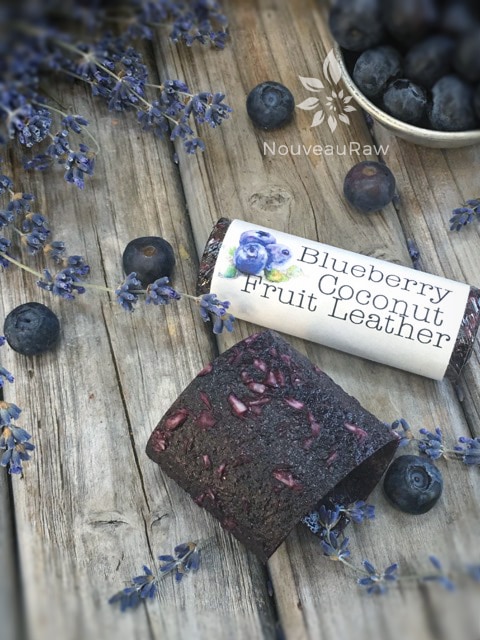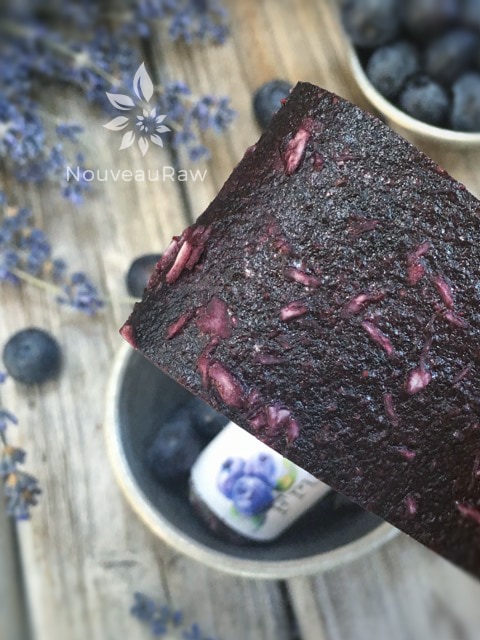Blueberry Coconut Fruit Leather

 Add to favorites
Add to favorites

~ raw, gluten-free, nut-free ~
Here is some fun trivia that everyone ought to know about blueberries…
- There are approximately 500 blueberries in a pound of farmed berries, and 1,600 berries in a pound of wild blueberries! Wild blueberries are much smaller than cultivated berries and are stronger in taste, but both types of blueberries are good for you, delivering several health benefits.
- The Blueberry is one of the few fruits that are native to North America (along with cranberries and concord grapes).
- If all the blueberries grown in North America in one year were spread out in a single layer, they would cover a four-lane highway stretching from New York to Chicago.
- Blueberry Jelly Bellies were created especially for Ronald Reagan.
- Soldiers in the Civil War regularly drank a blueberry beverage because of its health benefits.
According to information from the USDA National Nutrient Database, a 1 cup serving of fresh blueberries contains 3.6 g of fiber, which is a whopping 14 percent of the recommended daily intake. Vitamins in blueberries include vitamins K, C, A, E, and the B family. Minerals include potassium, manganese, copper, zinc, phosphorous, iron, calcium, and magnesium. With almost no fat except a trace of healthy omega-3 and omega-6 fatty acids and only 84 calories in a 1 cup serving, blueberries make a healthy addition to any diet. So, don’t be skimpy, eat up!
 Ingredients:
Ingredients:
yields 2 cups
- 2 1/2 cup organic blueberries
- 2 Tbsp whole chia seeds, ground
- 1 Tbsp raw honey
- 2 Tbsp shredded coconut
Preparation:
- Select RIPE or slightly overripe blueberries that have reached a peak in color, texture, and flavor.
- Puree the blueberries, ground chia, and honey, in the blender or food processor until smooth. (don’t add the coconut yet). Taste and sweeten more if needed. Keep in mind that flavors will intensify as they dehydrate. When adding a sweetener do so a little at a time, and reblend, tasting until it is at the desired taste. It is best to use a liquid type sweetener. Don’t use granulated sugar because it tends to change the texture.
- Allow the puree to sit for 10 minutes, so the chia has time to thicken the puree.
- Spread the fruit puree on teflex sheets that come with your dehydrator. Pour the puree to create an even depth of 1/8 to 1/4 inch. If you don’t have teflex sheets for the trays, you can line your trays with plastic wrap or parchment paper. Do not use wax paper or aluminum foil.
- Lightly coat the food dehydrator plastic sheets or wrap with a cooking spray, I use coconut oil that comes in a spray.
- When spreading the puree on the liner, allow about an inch of space between the mixture and the outside edge. The fruit leather mixture will spread out as it dries, so it needs a little room to allow for this expansion.
- Be sure to spread the puree evenly on your drying tray. When spreading the puree mixture, try tilting and shaking the tray to help it distribute more evenly. Also, it is a good idea to rotate your trays throughout the drying period. This will help assure that the leathers dry evenly.
- Sprinkle the shredded coconut on top of the wet leather.
- Dehydrate the fruit leather at 145 degrees (F) for 1 hour, reduce temp to 115 degrees (F) and continue drying for about 16 (+/-) hours. Flip the leather over about halfway through, remove the teflex sheet, and continue drying on the mesh sheet. The finished consistency should be pliable and easy to roll.
- Check for dark spots on top of the fruit leather. If dark spots can be seen it is a sign that it is not completely dry.
- Press down on the fruit leather with a finger. If no indentation is visible or if it is no longer tacky to the touch, the fruit leather is dry and can be removed from the dehydrator.
- Peel the leather from the dehydrator trays or parchment paper. If it peels away easily and holds its shape after peeling, it is dry. If it is still sticking or loses its shape after peeling, it needs further drying.
- Under-dried fruit leather will not keep; it will mold. Over-dried fruit leather will become hard and crack, although it will still be edible and will keep for a long time
- Storage: To store the finished fruit leather…
- Allow the leather to cool before wrapping up to avoid moisture from forming, thus giving it a breeding ground for molds.
- Roll them up and wrap them tightly with plastic wrap. Click (here) to see photos of how I wrap them.
- Place in an air-tight container, and store in a dry, dark place. (Light will cause the fruit leather to discolor.)
- The fruit leather will keep at room temperature for one month, or in a freezer for up to one year.
Culinary Explanations:
- Why do I start the dehydrator at 145 degrees (F)? Click (here) to learn the reason behind this.
- When working with fresh ingredients, it is important to taste test as you build a recipe. Learn why (here).
- Don’t own a dehydrator? Learn how to use your oven (here). I do however truly believe that it is a worthwhile investment. Click (here) to learn what I use.
© AmieSue.com
Tags: Dairy Free, Gluten Free, Nut Free, Refined Sugar Free, Soy Free, sugar free, Vegan



 Add to favorites
Add to favorites
 Ingredients:
Ingredients:
Hi Amie,
I recently received a Dehydrator from my partner (He loves Jerky, so I think there was a hidden message there ;) Anyway this weekend I went dehydrating crazy and one of the receipes I made was the Blueberry and coconut fruit leather. It turned out splendidly!!! Thankyou very much for the recipe and keep them coming! I love getting your emails and learning more about Raw Food. PS If you have a really good (fail proof) Yoghurt Leather, please let me know… I had a bad experience with one last week.
Thankyou again and have a Wonderful Week!
Renata :)
Hello Renata,
Yay for your partner! hehe Having a dehydrator will really open your world in adding more healthy foods into your diet. It sounds like you know that already though. :) I am so happy to hear that you enjoyed this recipe. Fruit leathers are a great staple to have on hand. Last year I tried a fruit leather with a yogurt and it was ok… not recipe-sharing-worthy. I just sort of forgot about trying again. I just might have to. Are you wanting to use a raw yogurt or what brand do you use?
Thank you for commenting.. I appreciate it! Blessings, amie sue
Hello! I can’t tell you how much I am in love with your site, ALL OF IT!!
In this recipe, can you use frozen organic blueberries??
Thanks again!
PK
Thank you Paula, so happy to hear that! I hope you find a lot of wonderful things to try. Keep in touch if you try other recipes. I always love to hear how it goes. Yes, you can use frozen berries. Defrost them first. I tend to drain off the liquid before using them because much of it is water from the ice crystals that tend to form around the fruit. Have a great day, amie sue